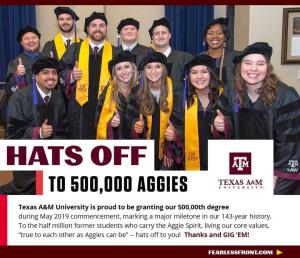Texas A&M University School of Law will launch August 26, 2019 its International Tax online curriculum for graduate degree candidates. Admissions is open for the inaugural cohort of degree candidates to pilot the launch of the Fall semester introductory courses of international taxation and tax treaties.
How do I apply for the inaugural cohort? Only for this inaugural cohort, completed applications may be submitted directly, via the below-expedited process, to the law school’s admission office until noon central daylight time (CDT – Dallas) on August 22, 2019. A completed Fall application must include four items:
(1) the completed and signed law school application (application fees and letters of recommendation are waived for Fall 2019 international tax);
(2) statement of interest for the international tax program that includes mention of prior tax or related experience.
(3) resume/CV reflecting at least three years of employment as a tax advisor or five years employment in a related field; and
(4) an official transcript from the highest academic degree awarded by an accredited University sent to Texas A&M University: Official electronic transcripts can be sent to law-admissions@law.tamu.edu FedEx, UPS, DHL express mail can be sent to Attn: Office of Graduate Admissions 1515 Commerce Street Fort Worth, TX 76102-6509
To apply for the inaugural cohort opportunity, contact Jeff Green, Graduate Programs Coordinator, T: +1 (817) 212-3866, E: jeffgreen@law.tamu.edu or contact David Dye, Assistant Dean of Graduate Programs, T (817) 212-3954, E: ddye@law.tamu.edu. Texas A&M Admissions website: https://law.tamu.edu/distance-education/international-tax
What is the proposed curriculum of 12 international tax courses?
International Taxation & Treaties I (3 credits) International Taxation & Treaties II (3 credits)
Transfer Pricing I (3 credits) Transfer Pricing II (3 credits)
Tax Risk Management (3 credits) FATCA & CRS (3 credits)
International Tax Planning (3 credits) Country Tax Systems (3 credits)
U.S. Int’l Tax (3 credits) EU Taxation (3 credits)
VAT/GST/Sales (3 credits) Customs & Excises (3 credits)
Ethics in Decision Making (1 credit required to graduate)
What distinguishes Texas A&M’s International Tax curriculum?
Since the original 1994 curriculum focus on tax risk management and methodology, the curriculum and the program operational structure continue to evolve based on in-depth industry research. “The central function of the tax office has evolved from strategy and planning into risk management”, says William Byrnes, professor of law and associate dean at Texas A&M University. “This evolution has been accelerated by trends — primarily globalization, transparency and regulatory reform — and by the OECD (through the project on Base Erosion and Profit Shifting, or BEPS), the United States (through the Foreign Account Tax Compliance Act) and the European Union.”
In 2019, Hanover Research on behalf of Texas A&M undertook an extensive long-form survey, including interviews, of 146 tax executives about the needs and value-added of Texas A&M’s new international tax curriculum. The surveys 2019 tax professionals included: 29% U.S. and 71% foreign resident. Half the participants were tax professionals of AmLaw 100 firms (27%) or of Big 4 accounting (21%). The other half of participants were tax professionals of large multinational tax departments in the following industries: Finance / Banking / Insurance; Consulting; Business / Professional Services; Computers (Hardware, Desktop Software); Telecommunications; Aerospace / Aviation / Automotive; Healthcare / Medical; Manufacturing; Food Service; Internet; Mining; Pharmaceutical / Chemical; Real Estate; and Transportation / Distribution. Four percent of survey participants were executive-level government tax authority staff.
Besides the actual design of the course curriculum, two interesting outcomes from the industry interviews are:
- The faculty and graduate degree candidates must be multidisciplinary, including both tax lawyers and non-lawyer tax professionals (e.g. accountants, finance executives, and economists) engaged together in learning teams with practical case studies and projects that are “applicable in a real-world context”.
- The curriculum must include the perspectives of tax mitigation and of tax-risk management with exposure to state-of-the-industry data analytics.
In its Tax Insights magazine that is distributed globally to clients, the Big 4 firm EY stated: “Texas A&M University is among the pioneers of change in tax education”.
Texas A&M professor William Byrnes explains: “A risk management approach to tax means that the new model will by definition be multidisciplinary. Financial and managerial accounting– and law– will still be important, of course. But students will also need new “hard” skills involving big data and communications technologies and “soft” skills geared to working in multicultural settings both at home and abroad.” Says Byrnes, “You don’t want to have people who are living in the ‘Stone Age’ (pre-2015) trying to work in a 2016-onward world.”
What is the proposed course schedule during an academic year?
Fall 2019 Part A (6 week term) Fall 2019 Part B (6 week term)
International Taxation & Treaties I International Taxation & Treaties II
Spring 2020 Part A (6 week term) Spring 2020 Part B (6 week term)
Transfer Pricing I Transfer Pricing II
Summer 2020 concurrent 6 week term
Tax Risk Management & Data Analytics FATCA & CRS
Fall 2020 Part A Fall 2020 Part B
International Tax Planning Country Tax Systems
International Taxation & Treaties I International Taxation & Treaties II
Spring 2021 Part A Spring 2021 Part B
U.S. Int’l Tax EU Taxation
Transfer Pricing I Transfer Pricing II
Summer 2021 concurrent term
VAT/GST/Sales Customs & Excises
Tax Risk Management FATCA & CRS
When are the semesters?
Fall: August 26 until December 14, 2019
Spring: January 9 until April 30, 2020
Summer: May 18 until July 11, 2020
Who is leading and creating this International Tax curriculum?
The International Tax curriculum has been developed and is led by Professor William Byrnes (Texas A&M University Law). In 1994, Professor William Byrnes founded the first international tax program leveraging online education and in 1998 founded the first online international tax program to be acquiesced by the American Bar Association and the Southern Association of Colleges and Schools. He is recognized globally as an online education pioneer focused on learner outcomes and best practices leveraging state of the art educational technology. William Byrnes is also an international tax authority as LexisNexis’ leading published author of nine international tax treatises and compendium, annually updated, and a 10 volume service published by Wolters Kluwer. His LinkedIn group International Tax Planning Professionals has over 25,000 members and is the largest international tax network on LinkedIn.
If you want to ask questions about the curriculum or how the online courses are as effective as residential ones, reach out to Professor William Byrnes at williambyrnes@law.tamu.edu.
How much time per week does a course require?
Each course unfolds over six weeks, designed to require 15 to 20 hours of input each week. This weekly input includes reviewing materials, listening to podcasts, watching video content, participating in discussion forums, engaging in live class sessions, and working with classmates on team-based learning projects. Working with the colleague groups on real-world case studies is critical to the educational experience. Potential applicants must have available three to five hours per week to spend developing and working with colleagues on group case studies using communications technologies like Zoom video.
What is the title of this graduate degree?
For lawyers, it is a Master of Laws (LL.M.) and for accountants, tax professionals and economists, it is a Master of Jurisprudence (M.J.). The degree is awarded by Texas A&M University via the School of Law. Completion of a curriculum, which is like a ‘major’ for university studies, is also recognized with a frameable certificate issued by the School of Law.
What are the minimum requirements of the application for each degree?
- All applicants must have previous domestic tax or accounting professional experience reflected on the CV of work experience.
- The Master of Laws (LL.M.) is awarded to successful graduates who hold a law degree from a law school or faculty of law that is accredited by the American Bar Association or if a foreign law degree then accredited by a governmental accreditation body and that allows the graduate eligibility for that country’s practice of law.
- The Master of Jurisprudence (M.J.) is awarded to all other successful graduates. Applicants for the Master of Jurisprudence must hold a prior degree from an accredited academic institution in business, accounting, finance, economics, or related business field.
What are the program requirements to graduate?
The Master of Laws candidates must complete at least 24 credits to be eligible to graduate. The Master of Jurisprudence candidates must complete at least 30 credits to be eligible to graduate.
All candidates must complete the Ethics in Decision Making course to be eligible to graduate, which presents networking opportunities with candidates of the Risk management and Wealth Management curricula. Master of Jurisprudence candidates must also complete an Introduction to U.S. Law course which will include networking among all law graduate curricula.
Candidates must complete at least six courses specific to a curriculum in order to be eligible for a degree. Without permission, candidates are allowed to enroll in up to two courses from another curriculum.
How many months to graduate?
Normally, candidates will enroll in two courses during Fall and Spring semester, focusing on one course each term (Fall and Spring have two terms of six weeks each). Candidates may enroll in one or two courses for the Summer semester, which is only one six-week term. Thus, most candidates will reach eligibility to graduate within two years. Candidates have the flexibility as to how many or few courses to enroll each term, subject to university graduate program rules. Candidates may complete the program in one year to as long as four years. Each course in a curriculum is offered once per year.
Are these degrees eligible for the Aggie Ring and membership in the Texas A&M Former Student Network (Texas A&M alumni)?
Yes, all international tax graduates will become a member of the Texas A&M family. Texas A&M is renown for the loyalty and engagement among its former students within the Texas Aggie clubs established throughout the world. Texas A&M has graduated over 500,000 “Aggies” who are eligible to wear the Texas A&M ring to identify each other throughout the world. See https://www.aggienetwork.com/
Will there be on-campus opportunities?
Yes. Graduation, with on-campus activities hosted at the law school, is May 1, 2020. October 24-25, 2019 is a networking conference of the risk, wealth, and international tax graduate students piggybacking on Texas A&M’s Financial Planning conference: Thursday night networking banquet and Friday conference activities. See https://financialplanning.tamu.edu/events/conference/ Saturday, October 26, 2019 is a Texas A&M football game at the on-campus Kyle stadium that two years ago underwent a $485 million renovation. The graduate program office has inquired about a block of tickets in the same section for students interested in purchasing a ticket and staying over for the game. Texas A&M football games are sold out with a capacity of over 100,000 seats and thus, Friday night hotel reservations in College Station should be made ASAP. Other opportunities will be announced during the program year.
What is Texas A&M University?
Texas A&M, the second largest U.S. public university, is one of the only 60 accredited U.S. members of the American Association of Universities (R1: Doctoral Universities – Highest Research Activity), and one of the only 17 U.S. universities that hold a triple U.S. federal designation (Land, Sea, and Space). As one of the world’s leading research institutions, Texas A&M is at the forefront in making significant contributions to scholarship and discovery: research conducted in fiscal year 2017 at Texas A&M represented an annual expenditure of more than $900 million. The Texas A&M University system’s operating budget exceeds $4.6 billion and Texas A&M’s combined endowments are 7th largest among universities in the world.
Texas A&M is ranked 1st among national public universities for a superior education at an affordable cost (Fiske, 2018); ranked 1st of Texas public universities for best value (Money, 2018); and ranked 1st in nation for most graduates serving as CEOs of Fortune 500 companies (Fortune, 2019). During the program, a candidate learns Texas A&M’s traditions and six core values that are grounded in its history as one of the six U.S. senior military colleges: Loyalty, Integrity, Excellence, Leadership, Respect, and Selfless Service.
Which government and professional organizations accredit Texas A&M University?
For the complete list, see https://www.tamu.edu/statements/accreditation.html
What are the other curricula’s courses that are available to international tax candidates?
Risk Curriculum Wealth Curriculum
Enterprise Risk & Data Analytics Taxation of Business Associations
Information Security Management Systems Securities Regulations
Counter-Terrorism Risk Management Financial & Portfolio Management
Cybersecurity Income Tax Financial Planning
Anti-Money Laundering & Bank Principles of Wealth Management
Principles of Risk Management Estate Planning, Insurance, and Annuities
Foreign Corrupt Practices Act Advanced Wealth Management
Fiduciary & Risk Management Non-Profit & Fiduciary Administration
White-Collar Crime Retirement & Benefits
Legal Risk Management Insurance Law (& Alternative Risk Transfer)
Financial Innovations
What is the tuition? Normal Texas A&M University tuition and available financial aid applies after the Fall term and is available at https://tuition.tamu.edu/ Texas A&M University is a public university of the state of Texas and is ranked 1st among public universities for its superior education at an affordable cost (Fiske, 2018) and ranked 1st of Texas public universities for best value (Money, 2018).








 the renown
the renown  presentation to respond to a real-world post-BEPS client study. Then all teams meet together online via Zoom twice each week at 8:00am Dallas time Wednesdays and Sundays to discuss and present the case study solutions. Students are
presentation to respond to a real-world post-BEPS client study. Then all teams meet together online via Zoom twice each week at 8:00am Dallas time Wednesdays and Sundays to discuss and present the case study solutions. Students are 








